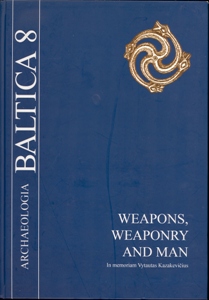Volume 8 (2007): Weapons, Weaponry and Man (In memoriam Vytautas Kazakevičius), November 2007

Order by:
Pub. online: 9 Nov 2007
Type: Introduction
 Open Access
Open Access
Journal:
Archaeologia Baltica
Volume 8 (2007): Weapons, Weaponry and Man (In memoriam Vytautas Kazakevičius), pp. 8–10
Pub. online: 9 Nov 2007
Type: List Of Contributors
 Open Access
Open Access
Journal:
Archaeologia Baltica
Volume 8 (2007): Weapons, Weaponry and Man (In memoriam Vytautas Kazakevičius), pp. 11–14
Pub. online: 9 Nov 2007
Type: Article
 Open Access
Open Access
Journal:
Archaeologia Baltica
Volume 8 (2007): Weapons, Weaponry and Man (In memoriam Vytautas Kazakevičius), pp. 15–16
Pub. online: 9 Nov 2007
Type: Bibliography
 Open Access
Open Access
Journal:
Archaeologia Baltica
Volume 8 (2007): Weapons, Weaponry and Man (In memoriam Vytautas Kazakevičius), pp. 17–21
Pub. online: 9 Nov 2007
Type: Article
 Open Access
Open Access
Journal:
Archaeologia Baltica
Volume 8 (2007): Weapons, Weaponry and Man (In memoriam Vytautas Kazakevičius), pp. 22–31
Abstract
Pub. online: 9 Nov 2007
Type: Article
 Open Access
Open Access
Journal:
Archaeologia Baltica
Volume 8 (2007): Weapons, Weaponry and Man (In memoriam Vytautas Kazakevičius), pp. 32–38
Abstract
Pub. online: 9 Nov 2007
Type: Article
 Open Access
Open Access
Journal:
Archaeologia Baltica
Volume 8 (2007): Weapons, Weaponry and Man (In memoriam Vytautas Kazakevičius), pp. 39–46
Abstract
Pub. online: 9 Nov 2007
Type: Article
 Open Access
Open Access
Journal:
Archaeologia Baltica
Volume 8 (2007): Weapons, Weaponry and Man (In memoriam Vytautas Kazakevičius), pp. 47–57
Abstract
Pub. online: 9 Nov 2007
Type: Article
 Open Access
Open Access
Journal:
Archaeologia Baltica
Volume 8 (2007): Weapons, Weaponry and Man (In memoriam Vytautas Kazakevičius), pp. 58–68
Abstract
Pub. online: 9 Nov 2007
Type: Article
 Open Access
Open Access
Journal:
Archaeologia Baltica
Volume 8 (2007): Weapons, Weaponry and Man (In memoriam Vytautas Kazakevičius), pp. 69–84
Abstract